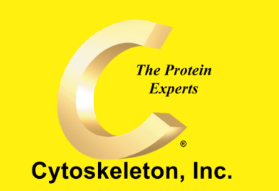當(dāng)前位置: 首頁(yè) - 熱銷(xiāo)產(chǎn)品 - 詳細(xì)內(nèi)容

Tubulin (Biotin Conjugate; Porcine Brain)
| 貨號(hào) | T333P-A | 售價(jià) | 5256 |
| 規(guī)格 | 5 x 20 μg | CAS號(hào) |
- 產(chǎn)品簡(jiǎn)介
- 相關(guān)產(chǎn)品
Product Uses Include:
Immobilizing tubulin onto a solid surface via streptavidin.
Creating tubulin or microtubule affinity matrices with streptavidin coated sepharose beads
High through-put screening using a proximity assay.
Microinjection into cells followed by electron microscopy of streptavidin conjugated gold particles to determine the cellular localization of the tubulin.
Nanotechnology
Material:
Porcine brain tubulin (>99% pure, see Cat. # T240) has been modified so that random surface lysines contain a covalently linked, long-chain biotin derivative. A long-chain biotin derivative was selected for this procedure because it allows the biotin molecules to be spaced far enough away from the tubulin protein so as not to interfere with its activity, e.g., ligand binding to SPA beads or other streptavidin based reagents. Biotin labeled tubulin is supplied as a lyophilized powder.
Cytoskeleton, Inc. also offers biotinylated cancer cell tubulin (Cat. # H003 )
Purity:
The protein purity of the tubulin used for labeling is determined by scanning densitometry of Coomassie Blue stained protein on a 4-20% polyacrylamide gel. The protein used for T333P is >99% pure tubulin. Labeled protein is run on an SDS gel, transfered to a nitrocellulose membrane and detected with streptavidin alkaline phosphatase (Fig 1). 10 ng of T333P is readily detectable. No free biotin is detectable in the final product.
Figure 1: Purity determination of biotin tubulin. 10 and 100 ng of T333P was run on a 4-20% SDS-PAGE gel, transferred to a nitrocellulose membrane and biotin labeled material was detected with streptavidin alkaline phosphatase.
Biological Activity:
The biological activity of T333P is assessed by a tubulin polymerization assay. To pass quality control, a 5 mg/ml solution of fluorescein labeled tubulin in G-PEM plus 5% glycerol must polymerize to >85%. This is comparable to unlabeled tubulin under identical conditions.


